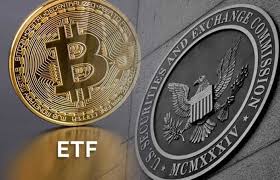Comparing the Pros and Cons of Bitcoin ETFs

There are currently two main types of Bitcoin ETFs, so let's take a look at the principles and advantages and disadvantages of each of them.
1. ETFs that actually hold bitcoin
This type of ETF is almost identical to the ETF we described earlier. The only difference is that the AP can choose to send cash, rather than bitcoin, to the ETF provider. Why? Because numerous APs don't want to hold huge amounts of bitcoin.
When the AP sends cash to the ETF provider, the ETF provider exchanges the cash for bitcoin. At the same time, the provider will return to the AP a share of the Bitcoin ETF with the same value (minus transaction fees).
The recent Bitcoin ETFs filed by VanEck and SolidX follow this model, and you can read more about the funds in their SEC filings.
merits
Low Transaction Costs: The cost of trading Bitcoin ETFs directly in the market is very low, eliminating the "friction" involved in converting fiat and bitcoin to each other.
Can track bitcoin's market performance: since the ETF holds bitcoin, it can track bitcoin's market performance very well. ap. It is possible to arbitrage between ETF price and NAV, eliminating significant discounts and premium trades.
Bitcoin is liquid: With billions of daily transactions in Bitcoin, the ample market liquidity makes the process of redemption simple.
disadvantages
Hacking Risk: ETF providers take security precautions to avoid bitcoin theft.
High cost per share required: retail investors likely won't have a chance to invest in the first wave of ETFs. in an effort to dispel the SEC's recommendation to protect retail investors Investors are concerned that VanEck's proposed Bitcoin ETF starts at 25 bitcoins for U.S. stocks.
High creation and redemption fees: bitcoin ETFs can cost more to create and redeem than traditional ETFs because when they choose to When submitting or redeeming a basket of cash, AP must pay a high transaction fee when creating and redeeming ETF shares (fiat vs. bitcoin) (Interchange). So far, VanEck plans to charge a fee of $1,000 for each created and redeemed transaction.
Bitcoin NAV is difficult to estimate: ETF redemptions are calculated based on NAV, so inaccurate NAVs will Breaking the arbitrage mechanism. The net asset value of most ETFs is calculated once a day. However, due to the volatility of the Bitcoin market price, intraday net asset value management is required. For example, the VanEck ETF plans to use the MVIS Bitcoin Index, which is updated every 15 seconds. Even so, determining an accurate net asset value remains difficult, as bitcoin prices on multiple exchanges may not be identical.
Bitcoin and Bitcoin ETF trading hours conflict: ETF trading hours do not coincide with when they are open on a digital currency exchange. During non-concurrent trading hours, i.e., when the ETF closes and the digital currency is trading normally, if the price of bitcoin falls significantly, the investor would not be able to mitigate losses in a closed market. Non-concurrent trading times may also increase the gap between the ETF price and NAV.
2. ETFs that hold bitcoin derivatives
Another type of Bitcoin ETF doesn't actually require holding Bitcoin. Instead, ETFs try to mimic Bitcoin's performance through derivatives such as Bitcoin futures, options, and money market instruments.
The Direxion Bitcoin ETF and the VanEck Vectors Bitcoin ETF are both examples of this type.
merits
The institution shouldn't need to worry about the security risks of holding bitcoin, because it doesn't hold it.
disadvantages
Bitcoin's market performance is difficult to mimic: because the Bitcoin ETF only approximates Bitcoin's performance, the fund's returns are not exactly in line with Bitcoin's performance.
Active management is risky and costly: the performance of bitcoin ETFs that hold bitcoin derivatives is entirely up to the fund manager Discretion. In order to better track Bitcoin's performance, managers will be more proactive, but this may result in a significantly lower return on their investment. Bitcoin's actual performance. In addition, the fund manager will charge a percentage of the management fee.
Margin Risk: Bitcoin futures contracts require margin payments. The Exchange also requires additional margin if the deposit margin does not meet the maintenance margin requirements. If sufficient cash or cash equivalents are not available, the futures contract will be liquidated and result in significant losses to the ETF. Both market volatility and leveraged trading make this more likely to happen. Under leveraged conditions, even relatively small price changes can lead to large-scale liquidation. Given the volatile nature of Bitcoin, this can be a huge risk if not handled properly. To make matters worse, even on a well-known futures exchange like Bitmex, there is manipulation of bitcoin prices to trigger additional Margin suspicion.
Leveraged trading risk: the heavy use of leveraged financial instruments means that even short-term price movements in Bitcoin can adversely affect the performance of ETFs.
ROLL RISK: Many investors switch to new futures contracts before the end of a futures contract, in the process of switching positions. This was done to delay the expiration of the contract in order to prevent settlement. If the future price of the contract is higher than the spot price, the investor loses money by rolling over the same amount of assets at the higher price.



